There’s nothing in the world like following a butterfly around a flower patch. They flit and dive as wind-carried floral scents call them in, and then they balance on a bloom, methodically seeking out nectar. But like so many pollinators, butterflies are under a lot of pressure, from habitat loss and a changing climate to the proliferation of pesticides and weed killers. It’s tough being a butterfly.
We can do a lot to welcome and learn about butterflies in home landscapes — even one aster can make a meaningful difference. It’s important to use plants native to your location since they will support the kinds of wildlife that need them and require less maintenance when properly sited. Here is a selection of superb native flowers that attract butterflies, moths and other pollinators.
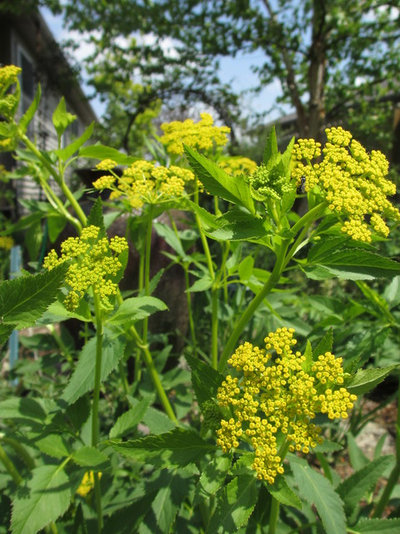
Benjamin Vogt / Monarch Gardens
1. Golden Alexanders (
Zizia aurea)
Native from eastern North Dakota south to eastern Texas and east to the Atlantic, from Maine to northern Florida
Blooming in mid-to-late spring, golden Alexanders welcomes a cornucopia of early-season pollinators, mainly small native bees, seeking pollen. Golden Alexanders also serves as a year-round host plant for black swallowtails.
Give it a little room to spread, as it does so by seed, and you’ll see an impressive drift of blooms that butterflies will notice from a distance.
Where it will grow: Hardy to minus 40 degrees Fahrenheit, or minus 40 degrees Celsius (USDA zones 3 to 8; find your zone)
Water requirement: Slightly dry to slightly moist soil
Light requirement: Full sun to partial sun
Mature size: 2 to 3 feet tall and 2 feet wide
See how to grow golden Alexanders
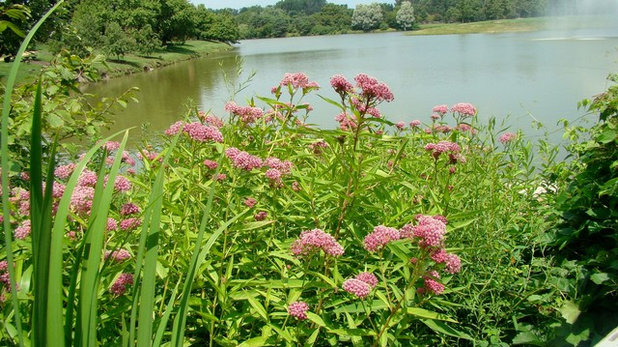
naturalmidwestgarden.com
2. Swamp Milkweed(
Asclepias incarnata)
Native in parts of all U.S. states except Washington, Oregon and California (West Coast gardeners can consider
A. speciosa, among others)
Contrary to its name, swamp milkweed enjoys more habitats than just swamps — even a partly sunny spot with medium to slightly dry soil will work.
Milkweeds are hosts to the monarch butterfly and many other species, including tussock moths, milkweed beetles and milkweed bugs. Of the roughly 100 milkweed species in the U.S., most folks say they see the most monarch egg laying on swamp milkweeds.
The blooms, which appear in the early-to-mid summer, emit a spicy vanilla scent and require a complex set of actions to be properly pollinated.
Where it will grow: Hardy to minus 40 degrees Fahrenheit, or minus 40 degrees Celsius (zones 3 to 9)
Water requirement: Moist to medium soil
Light requirement: Full sun to partial sun
Mature size: 2 to 4 feet tall and 2 to 3 feet wide
See how to grow swamp milkweed
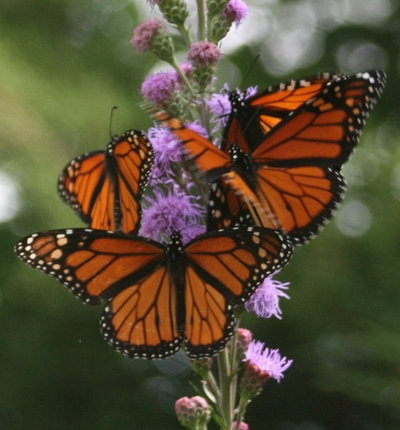
Benjamin Vogt / Monarch Gardens
3. Meadow Blazing Star(
Liatris ligulistylis)
Native in the Rockies from northern New Mexico to Montana, as well as Illinois, Missouri and Nebraska, and north into the Dakotas, Minnesota and Wisconsin
There are many blazing stars in nature, though we tend to see only two or three species for sale in most nurseries. Meadow blazing star has a smaller range than other species, but it really is a monarch butterfly nirvana, as you can see here.
Bulb-like corms slowly develop a few years before midsummer flower stalks shoot up. At maturity, a single plant will have several stalks.
Where it will grow: Hardy to minus 40 degrees Fahrenheit, or minus 40 degrees Celsius (zones 3 to 7)
Water requirement: Slighty dry to slightly moist soil
Light requirement: Full sun to partial sun
Mature size: 3 to 4 feet tall and 1 foot wide
See how to grow meadow blazing star
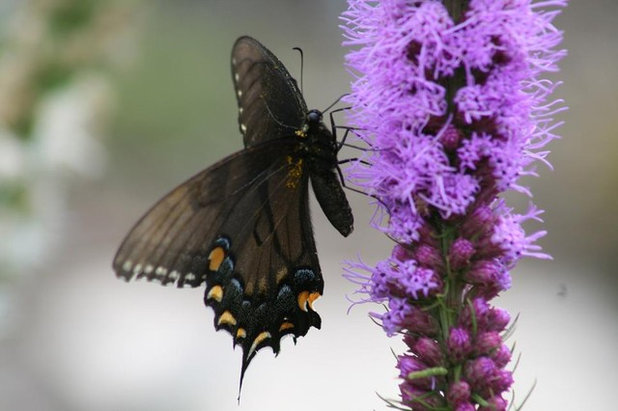
Benjamin Vogt / Monarch Gardens
4. Prairie Blazingstar (
Liatris pycnostachya)
Native from eastern North Dakota south to eastern Texas and east from Indiana to Mississippi
Most blazing stars are highly attractive to adult butterflies, as well as moths and bumblebees. In this image, an eastern tiger swallowtail is enjoying a hearty meal.
Prairie blazing star is often seen for sale in nurseries along with dense blazing star
(
L. spicata); both also come in white hybrids which, at least in my garden, are far less attractive to pollinators.
Where it will grow: Hardy to minus 40 degrees Fahrenheit, or minus 40 degrees Celsius (zones 3 to 9)
Water requirement: Moist to medium soil
Light requirement: Partial sun to full sun
Mature size: 3 to 6 feet tall and 1 foot wide
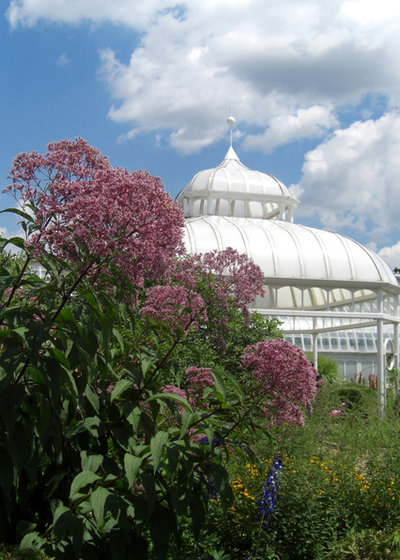 5. Sweet Joe Pye Weed
5. Sweet Joe Pye Weed(
Eutrochium purpureum)
Native from South Dakota to Oklahoma and east from Maine north to Florida
There are several Joe Pye species, but this mid-to-late summer bloomer is most available. In full sun, it likes a medium to somewhat moist soil, and in part shade, it likes a medium soil — though it will be shorter and with fewer blooms.
The plant looks almost tropical in its foliage, and the hollow stems, when left 2 to 3 feet tall in spring, make excellent homes for bees. It slowly spreads outward over the years to form a dense clump with a stout stature.
Where it will grow: Hardy to minus 30 degrees Fahrenheit, or minus 34.4 degrees Celsius (zones 4 to 9)
Water requirement: Moist to medium soil
Light requirement: Full sun to partial sun
Mature size: 5 to 7 feet tall and 3 to 4 feet wide
See how to grow sweet Joe Pye weed
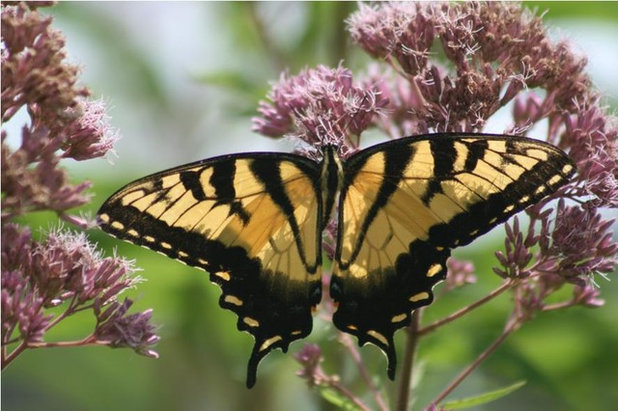
Benjamin Vogt / Monarch Gardens
Tiger swallowtails seem to be especially attracted to Joe Pye weed flowers, though you’ll see a variety of butterflies, moths and bees stopping by as well.
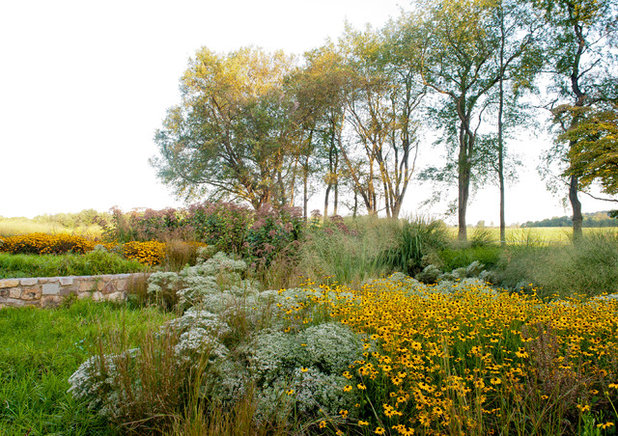
jonathan alderson landscape architects, inc.
6. Boneset (
Eupatorium perfoliatum)
Native from North Dakota south to Texas and east from Maine south to the Florida
Boneset doesn’t set bones the way early pioneers thought, but it does support a lot of pollinators. Like its cousin Joe Pye weed, boneset attracts a diversity of butterflies to its midsummer blooms. Boneset is also a host plant for several moth species. It requires consistent moisture to look its best and put on a good flower show.
Where it will grow: Hardy to minus 40 degrees Fahrenheit, or minus 40 degrees Celsius (zones 3 to 8)
Water requirement: Moist to medium soil
Light requirement: Full sun to partial sun
Mature size: 2 to 4 feet tall and 1 foot to 2 feet wide
See how to grow boneset
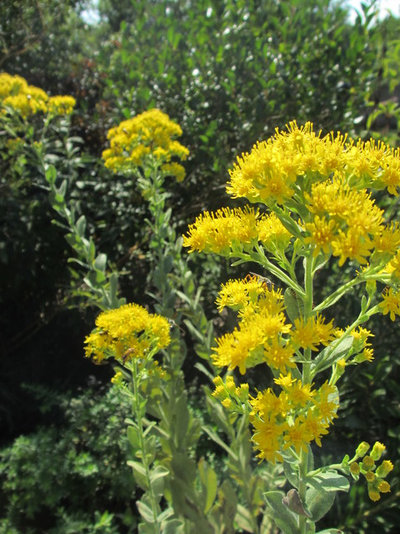
Benjamin Vogt / Monarch Gardens
7. Stiff Goldenrod(
Oligoneuron rigidum)
Native from Montana south to New Mexico and all parts east, from Massachusetts south to Georgia
Goldenrods, in general, are about the best group for supporting adult pollinators like butterflies. Their pollen is sticky and heavy, not airborne, and doesn’t cause hay fever (that culprit is ragweed). Drought-tolerant but preferring consistent moisture, stiff goldenrod has tall stems that provide ideal perches for butterflies to sun themselves, even after the early-autumn flowers have passed. Goldenrods host a plethora of moth species, which is nice since they support very large food webs.
Where it will grow: Hardy to minus 40 degrees Fahrenheit, or minus 40 degrees Celsius (zones 3 to 8)
Water requirement: Slightly moist to dry soil
Light requirement: Full sun to partial sun
Mature size: 3 to 4 feet tall and 1 foot to 2 feet wide
See how to grow stiff goldenrod
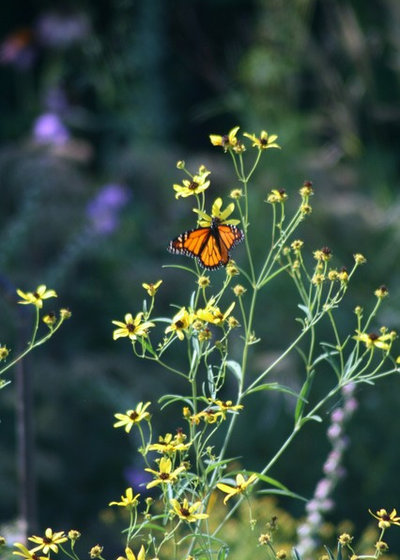
Benjamin Vogt / Monarch Gardens
8. Tall Tickseed(
Coreopsis tripteris)
Native in areas from the central and southern Great Plains to the Southeast and central East Coast
You can’t go wrong with any of our native
Coreopsis species, but if you like some architectural interest without blocking the view, tall coreopsis is your choice. It slowly spreads by runners to form stout colonies.
A long bloom time in mid-to-late summer ensures a constant nectar supply for butterflies and pollen for bees. Leaving the stalks up in spring also provides great housing for carpenter bees. Some moth species feed on the leaves, and others on the flower petals.
Where it will grow: Hardy to minus 40 degrees Fahrenheit, or minus 40 degrees Celsius (zones 3 to 8)
Water requirement: Slightly dry to slightly moist soil
Light requirement: Full sun to partial sun
Mature size: 5 to 8 feet tall and 3 to 6 feet wide or more
See how to grow tall tickseed
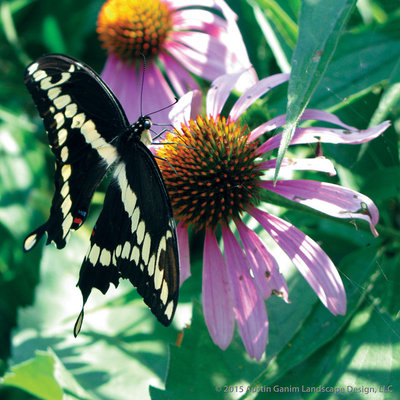
Austin Ganim Landscape Design, LLC
9. Purple Coneflower(
Echinacea purpurea)
Native from Nebraska south to Texas and all parts east, from Vermont south to Florida, with its primary range being the Midwest and eastern Great Plains
Sure, everybody plants purple coneflower, but there’s a reason. A lot of creatures visit it when it’s in bloom, from bees to beetles and wasps to butterflies. Here you can see a pipevine swallowtail enjoying itself.
There are several other coneflower species to consider, from pale purple coneflower (
E. pallida) to Tennessee purple coneflower (
E. tennesseensis).
Where it will grow: Hardy to minus 40 degrees Fahrenheit, or minus 40 degrees Celsius (zones 3 to 9)
Water requirement: Slightly dry to slightly moist soil
Light requirement: Full sun to partial sun
Mature size: 2 to 3 feet tall and 1 foot to 2 feet wide
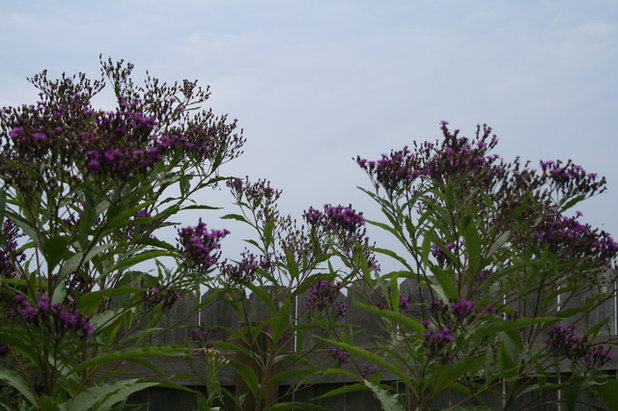
Benjamin Vogt / Monarch Gardens
10. Baldwin’s Ironweed(
Vernonia baldwinii)
Native from South Dakota to Colorado to Texas and east, from Illinois to Louisiana
While there are many ironweed species, Baldwin’s ironweed is unique for its shorter stature and ability to withstand drought. All ironweeds will attract butterflies and long-tongued bees looking to sip some sweet nectar, while Baldwin’s ironweed hosts a few moth species. Give it any soil type, from clay to rocky sand, and you’ll be good to go.
Where it will grow: Hardy to minus 40 degrees Fahrenheit, or minus 40 degrees Celsius (zones 3 to 9)
Water requirement: Medium to dry soil
Light requirement: Full sun to partial sun
Mature size: 3 to 5 feet tall and 2 to 4 feet wide
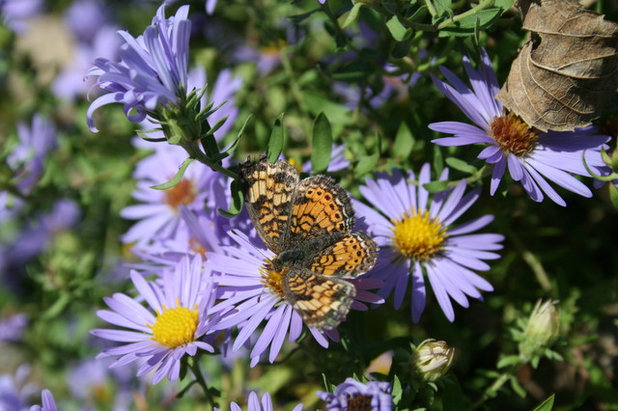
Benjamin Vogt / Monarch Gardens
11. Smooth Aster(
Symphyotrichum laeve)
Native just about everywhere except California
Like goldenrods, asters are powerhouses and community builders when it comes to pollinators. Smooth aster will attract large numbers and diversity of insects in early-to-mid fall; as for butterflies, it will be most attractive to the smaller species like admirals, skippers, sulfurs and this crescent (pearl crescents use it as a host plant). Smooth asters are also rather adaptable in the landscape, and their long blue leaves add smooth texture to the garden.
Where it will grow: Hardy to minus 30 degrees Fahrenheit, or minus 34.4 degrees Celsius (zones 4 to 8)
Water requirement: Slightly moist to slightly dry soil
Light requirement: Full sun to partial sun
Mature size: 2 to 4 feet tall and 1 foot to 2 feet wide
See how to grow smooth aster
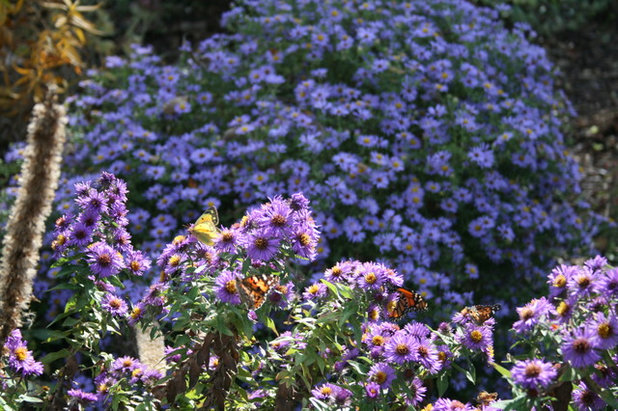
Benjamin Vogt / Monarch Gardens
12. Aromatic Aster(
Symphyotrichum oblongifolium)
Native from eastern Montana to New Mexico and east, from Pennsylvania south to Alabama
Hands down, this is my favorite aster. It has a nice shrubby appearance, blooms late into autumn and shrugs off drought like a champ. In fact, it prefers rocky soils but does great in clay.
Aromatic aster is a host to the silvery checkerspot butterfly. The late-autumn bloom is critical for insects (like some native bees) that are still completing their nesting and for migrating butterflies.
Where it will grow: Hardy to minus 40 degrees Fahrenheit, or minus 40 degrees Celsius (zones 3 to 9)
Water requirement: Dry to medium soil
Light requirement: Partial sun to full sun
Mature size: 1 foot to 2 feet tall and 2 to 3 feet wide
See how to grow aromatic aster
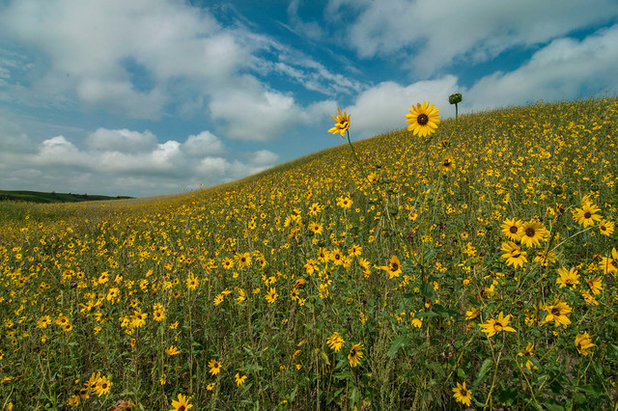
Chris Helzer
13. Prairie Sunflower(
Helianthus petiolaris)
Native from Wisconsin to Missouri, west through Texas and the Dakotas to Nevada and Arizona; not native to Pacific Northwest
Sunflowers are magical plants. They provide copious amounts of pollen and nectar — and not just nectar on the flower, but also something called extra floral nectar on the back of the bloom and in places along the stem. Prairie sunflower is an annual sunflower that self-sows in open areas where plant competition is less.
Where it will grow: Annual; hardy to minus 40 degrees Fahrenheit, or minus 40 degrees Celsius (zones 3 to 9)
Water requirement: Dry to medium soil
Light requirement: Full sun to partial sun
Mature size: 2 to 4 feet tall and 1 foot to 2 feet wide
See how to grow prairie sunflower
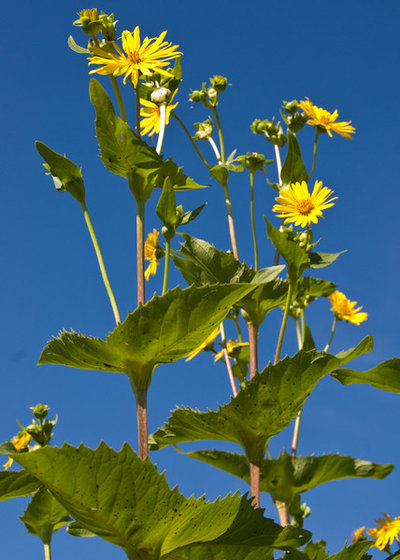
Holm Design & Consulting LLC
14. Cup Plant(
Silphium perfoliatum)
Native to eastern North America, from North Dakota south to Oklahoma and east to Georgia in the south and Maine in the north; also occurs in Canada, in Ontario and Quebec
A sunflower cousin, this native flower does a lot in the environment besides welcoming butterflies to its warm blooms. The stems make fantastic bee homes, while the large leaves form a cup around the stem, which collects water for birds and insects to drink. Another tall plant, it lends itself well to butterflies that need a place to hang out and sun themselves during cool mornings or evenings.
Where it will grow: Hardy to minus 40 degrees Fahrenheit, or minus 40 degrees Celsius (zones 3 to 8)
Water requirement: Slightly moist to medium soil
Light requirement: Full sun to partial sun
Mature size: 3 to 10 feet tall and 5 feet wide
See how to grow cup plant
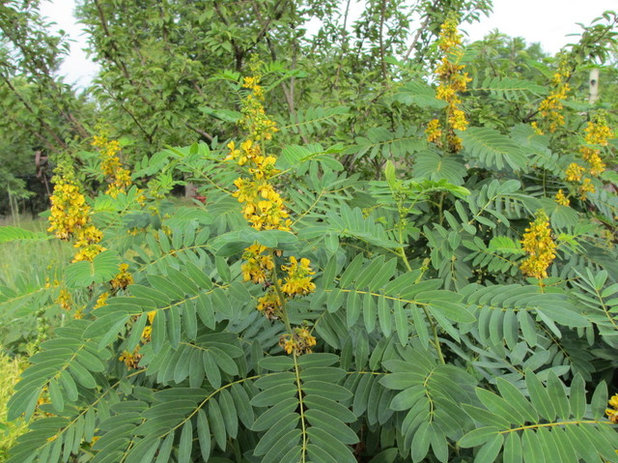
Benjamin Vogt / Monarch Gardens
15. Wild Senna(
Senna hebecarpa)
Native from Wisconsin south to Alabama and east to the Carolinas and New England
I’m going to cheat a bit with this plant to make a point. I’m not sure I’ve ever seen a butterfly sipping nectar on senna — its primary visitors are masses of bumblebees. However, I have seen countless sulfur butterfly eggs.
The point is this: While we want pretty flowers that welcome pretty butterflies, we must have even larger numbers of plants that grow butterflies from egg to wing. Wild senna and its sibling Maryland senna (
S. marilandica) fit the bill as two adaptable, stout and long-blooming plants that flower for almost a month in midsummer.
Where it will grow: Hardy to minus 30 degrees Fahrenheit, or minus 34.4 degrees Celsius (zones 4 to 8)
Water requirement: Moist to slightly dry soil
Light requirement: Full sun to partial sun
Mature size: 4 to 6 feet tall and 3 to 5 feet wide
See how to grow wild senna





